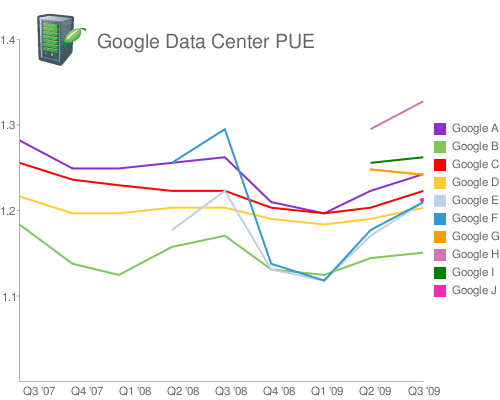
This graphic shows the trends in PUE at Google data centers.
Google's latest quarterly update of the energy efficiency of its data centers showed a slight uptick from the previous quarter, but improvement from the same period last year. The company publishes its efficiency data using Power Usage Effectiveness (PUE), the leading metric for "green" data centers.
"Overall, our fleet QoQ results were as expected," Google reported. "The Q3 total quarterly energy-weighted average PUE of 1.22 was higher than the Q2 result of 1.20 due to expected seasonal effects. The trailing twelve-month (TTM) energy-weighted average PUE remained constant at 1.19. YoY performance improved from facility tuning and continued application of best practices. The quarterly energy-weighted average PUE improved from 1.23 in Q3'08, and the TTM PUE improved from 1.21."
The company said its PUE ratings are also changing due to the addition of new facilities, whose energy usage tends to fluctuate as they gradually add more workloads. "New data centers G, H, I, and J reported elevated PUE results as we continue to tune operations to meet steady-state design targets," Google said.
PUE is a standard promoted by The Green Grid and others in the data center industry to provide a consistent way to measure the ratio of power delivered to IT equipment versus the total amount of power used by the facility. PUE allows data center managers to calculate how much power is driving the actual IT equipment versus non-IT elements such as cooling and lighting.
See the Going Green section of Google's web site for more details on its data center efficiency.




